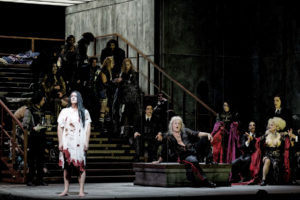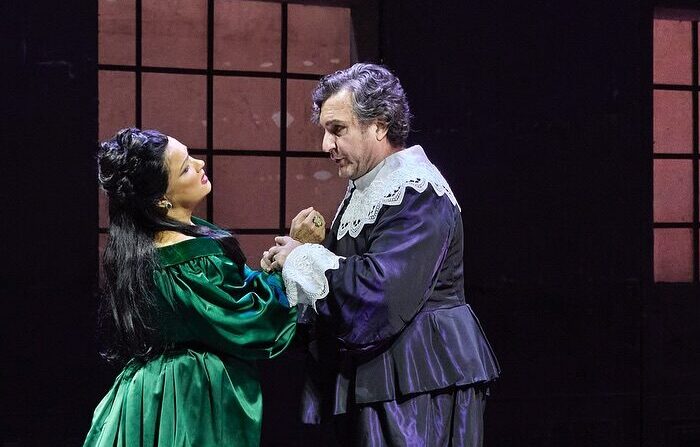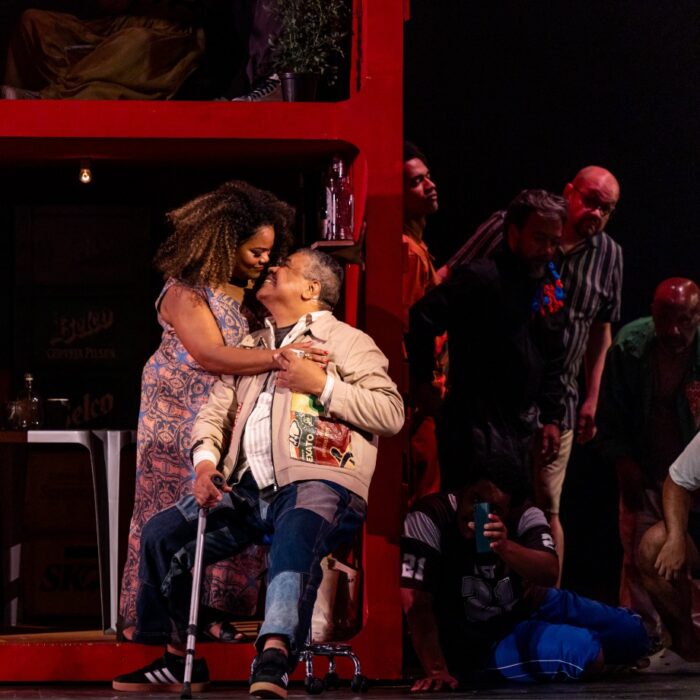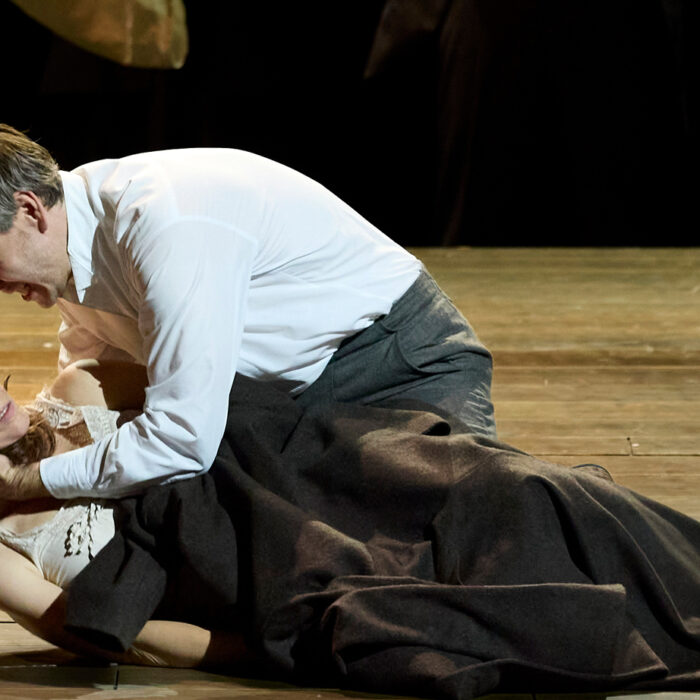
Opéra National de Paris 2022-23 Review: Salome
Elza Van Den Heever & John Daszak Shine in Strange & Uneven New Staging
By João Marcos Copertino(Credit: Agathe-Poupeney)
This review compiles performances attended on Oct 15, 18 and Nov. 5.
When conductor Simone Young entered the stage to be applauded after her performance in Paris Opéra’s new production of “Salome,” some incipient voices started to boo her. The booers quickly realized their error; they actually wanted to hoot the staging team commanded by Lydia Steier.
It had all been forecasted in advance; the Paris Opéra even sent ticketholders an email warning about the production’s violent and sexual content—yes, “Salome” has trigger warnings now (!). Whatever its faults, Steier’s hardcore #metoo-ish staging brought back some of the discomfort that Wilde, and Strauss and Lachmann’s, “Salome” might have aimed for in 1905.
Raising the Question
“Salome“—the opera, and the play—raises the question of how to make desire representable. Characters, seeing ordinary things, project their unordinary fates and aspirations. Recall all the visions characters have of the moon! To represent desire in the opera risks visual vulgarity or an idle idyll. Lydia Steier chose to focus on the act of desiring itself rather than on representing desirable objects or persons—she shows us the gazer instead of objectifying the gazed-upon. In her vision, there is no moon, no real dance, and Salome is dressed as Ringu film ghost. These decisions brought needed dramatical strength to the opera, but also, progressively, exposed some deep political problems in Steier’s conceptualization.
The opera is set in an astonishing post-apocalyptic bunker designed by Momme Hinrichs, and (well-)lit by Olaf Freese, with the action unpacked in two layers. Upstairs, we see, through glass windows, a lustful Herod’s party in which guests are continuously fed by nude women—and a man—who are all eventually murdered. Most partygoers wear queer-coded punk costumes—like Bobby Mackie’s iconic Cher gowns—, but the Jews wear black-tie, like fin-de-siècle dandies. Downstairs are the guards—in Star Wars costumes—, with Jochanaan’s pit, and, of course, a hole where the dismembered bodies of the party’s victims are thrown.
Although noisy, the action is well synchronized. Steier—and dramaturgist Maurice Lenhard—coordinated the murders of the nude women and the single nude man (!)—with Jochanaan’s vociferations; the sexual activities upstairs become more frenzied as Salome proclaims her desire for the prophet, etc.
The post-apocalyptical aesthetics worked well and seemed suitable to Oscar Wilde’s original text. Indeed, Andy Besuch’s costumes reference, in their own way, Aubrey Beardsley’s drawings, published in the first English edition of “Salome.” The now notorious gown with Herodias’ exposed breast is not new, though Karita Mattila’s (fake) breasts with nipple piercings were a small innovation.
Toward the end of the third scene, however, the main flaws of the staging popped out. Iain Paterson sang Jochanaan’s “Ich will dich nicht ansehn. Du bist verflucht, Salome” (“I will not look at thee. Thou art accursed, Salome”) staring at Salome, as if he himself were also falling under her charm. Salome, inebriated by such words, starts to masturbate following the music that leads to Herod’s entry. The masturbation, though uncomfortable, is explainable; Jochanaan’s gaze, not so much.
Steier’s dance of the seven veils is (almost) a representation of a collective rape. Salome moves very little. The action is all Herod’s, and eventually that of his guests, who leave her clothes ripped and full of blood. It was hard to watch, but it made a point about staging the opera in a #metoo era.
The final moments of the opera are an unjustifiable scenic mess. Salome receives Jochanaan’s head, but shortly after, she is severely wounded by a guard—without Herod’s approval—and hallucinates until her death. An actress lies on the stage while the real Salome sings in Jochanaan’s cage, with a prophet still alive to share her romantic gazes and return her kisses. His pit, now their pit, is elevated, fluctuating onto the proscenium, while Herod, Herodias, and all their party guests are murdered by the page in an act of rebellious vindication.
It is interesting to consider the motivations that could lead Steier to such bold choices in the finale, but the political implications are not as great as director would seem to think. On the one hand, Steier aimed to make the opera a critique of neoliberal society— a bit of a platitude nowadays. What happens instead is a condemnation of all sexual lust and desire, with the exception of Salome’s, and she is now a victim of her terrible parents and of male sexual lust.
On the other, its killing of all the queer-coded guests and its failure to address the opera’s inherent antisemitism are political flaws. However provocative its interrogation of the gazer, the production ends on a slightly prudish note with little place for irony. The virtuous ending left me with a bitter taste—would it be the taste of love?
Uneven Performers
Performance-wise, the night was exciting, but uneven.
Elza van den Heever proved herself a great actress. Her Salome was strong and willful, as she should be, while also conveying the intensity of her desire and its frustrations. Vocally, her performance grew over the night. She does have the vocal material for the part, but there were some issues in her projection in the third scene, especially in the mid-range and low notes. Her great moment was the final scene, in which the phrasing got closer to a speaker tone with great dramatical wins.
Van den Heever’s only peer was John Daszak’s Herod. Embracing all the sexual awkwardness and male dominance that the staging demands, his sonorous and loud voice connected him to the tradition of singers like Julius Patzak and Gerhard Stolze: the tone was not particularly pretty, but it was extremely compelling, musically and scenically. In Herod’s many hallucinations moments, Daszak phrased beautifully, constructing a piano in the terminations that stressed his failure as an autocrat.
Karita Mattila, once Salome herself, offered her scenic charisma to Herodias. Despite her great acting, her voice did not work out so well, resonating very little in the mid and lower notes. That said, her high notes are still quite efficient. She showed her talent, however, singing “er soll schweigen” (“Command him to be silent.”); nothing was rushed, even in the hard interval, from an A5 to a G4.
Iain Paterson missed many scenic and vocal opportunities in his portrayal of Jochanaan. His voice did not prove to have the stamina and strength of a character that is so sonorously present even when offstage. His confrontation with Salome lacked a
colorful range of tones: there was little difference in the affect and sound between his prophesy of the Messiah (“Menschen Sohn”/ “Son of Man”) from his utterance Salome’s damnation—the usually very sonorous “Du bist verflucht” (“thou art
accursed”). In most of his offstage singing, his voice, hardly audible in the second balcony, was noticeably weakened in the parterre. To be fair, the staging, confining him entirely to a small cage, gave him little space to do anything with his acting.
Tansel Akzeybek’s Narraboth was vocally fine; the acting was monolithic but sympathetic. The great surprise was Katharina Magiera’s vocal warmth as the page. Her mezzo tone filled the Opéra space, making her presence sufficiently remarkable
until the last moment of the opera when they massacred all aristocrats.
In the poor acoustics of Opéra Bastille, the second balcony is the best place to hear the orchestra, from whom Simone Young elicited beautiful sounds and nuances. Many moments had an amazing orchestral texture, especially in the heavy brass moments. When I listened to it from the parterre, things were not as interesting. The sound upstairs was so good that, on the night of Oct. 18, during the turbulent dance scene, I even flirted with the idea of closing my eyes, not only to avoid the intentional embarrassment of the mise-en-scène, but also to enjoy such well-executed orchestral moments.
I personally had a hard time understanding Lydia Steier’s being booed on the opening night. Her staging, though not perfect, resuscitated aspects of “Salome” that were essential to the success and modernity of the original play and opera. It is a pity that she has not returned to receive her applause in the following nights; opening night, there were more than a few empty seats in the second balcony (the cheapest part of the house), but when I returned to see the following performance, Oct. 18, the house seemed full. In fact, I invited friends to come and see it.
On the final night, with the house full again, all cheap tickets were sold out. If my impression is correct, the scandale of “Salome” still mobilizes people to come over and over again.
Ps.: All the English quotations of Oscar Wilde’s Salomé are from Lord Alfred Douglas’ translation, revised by Wilde, and widely available now. The play, as one might know, was written in French.


